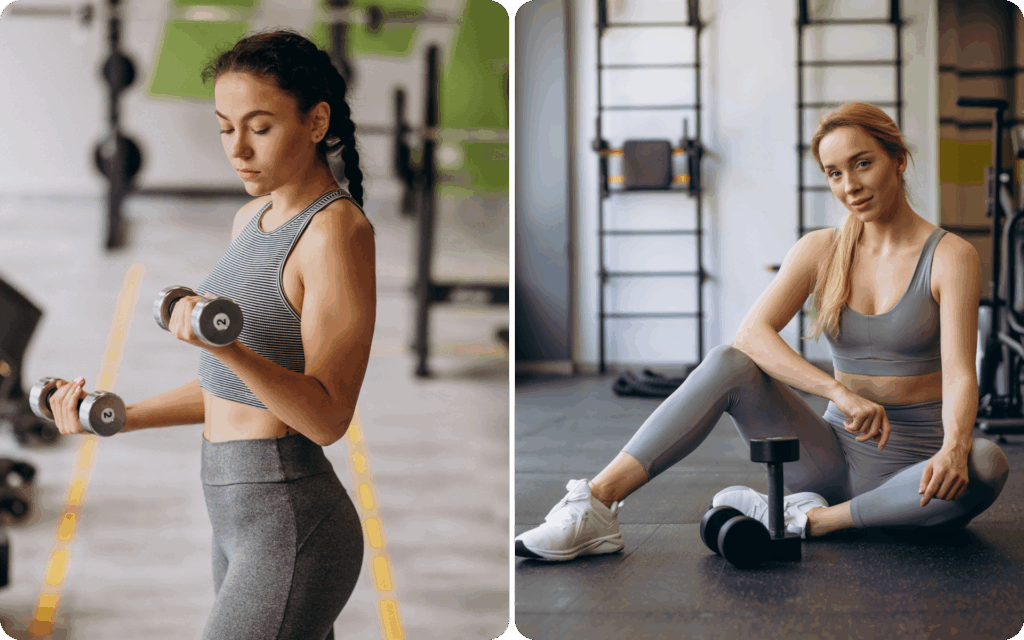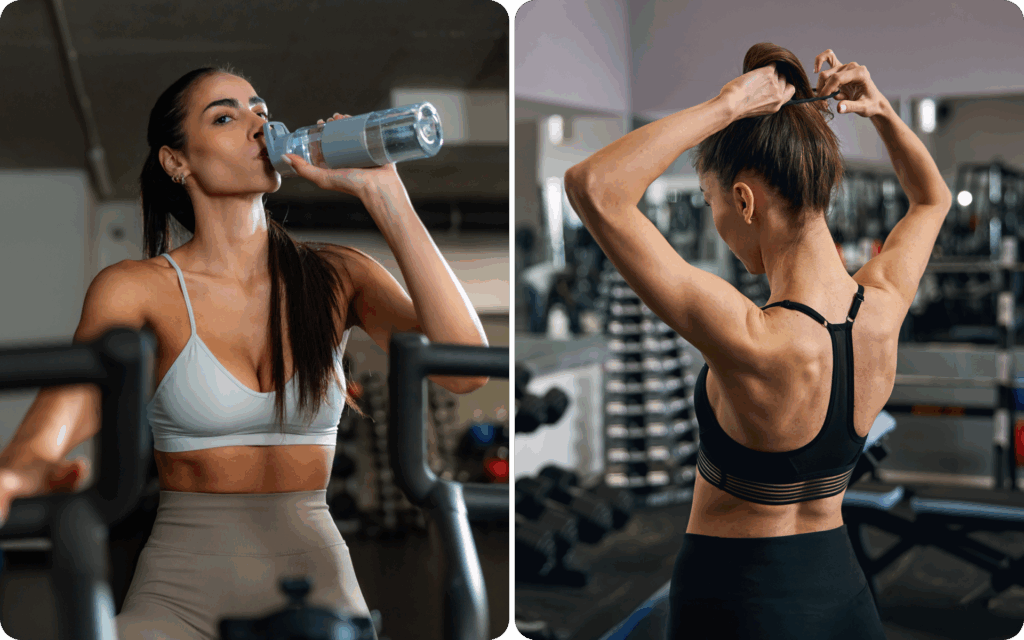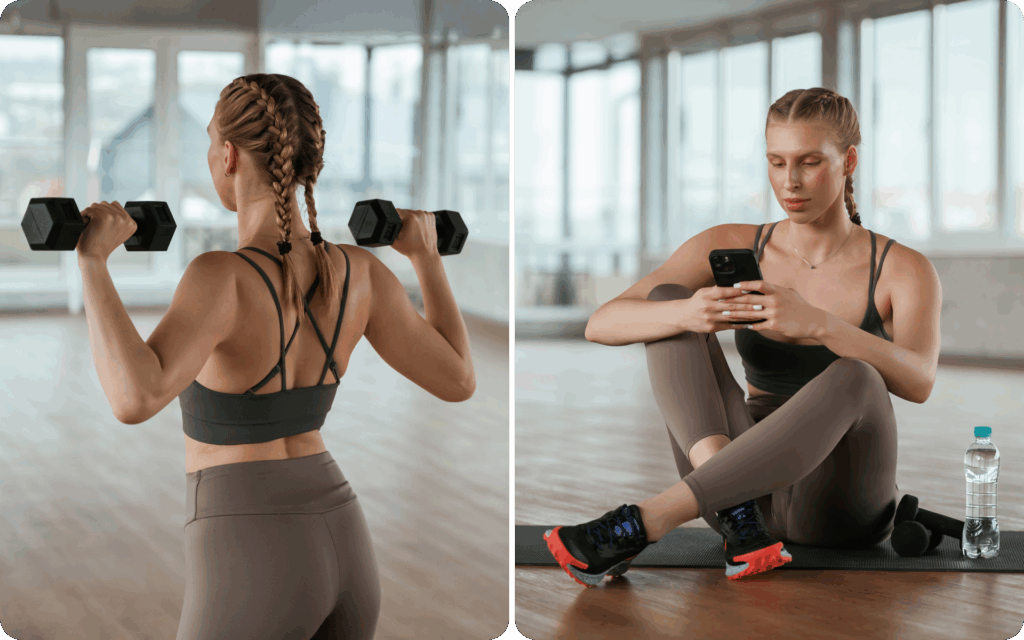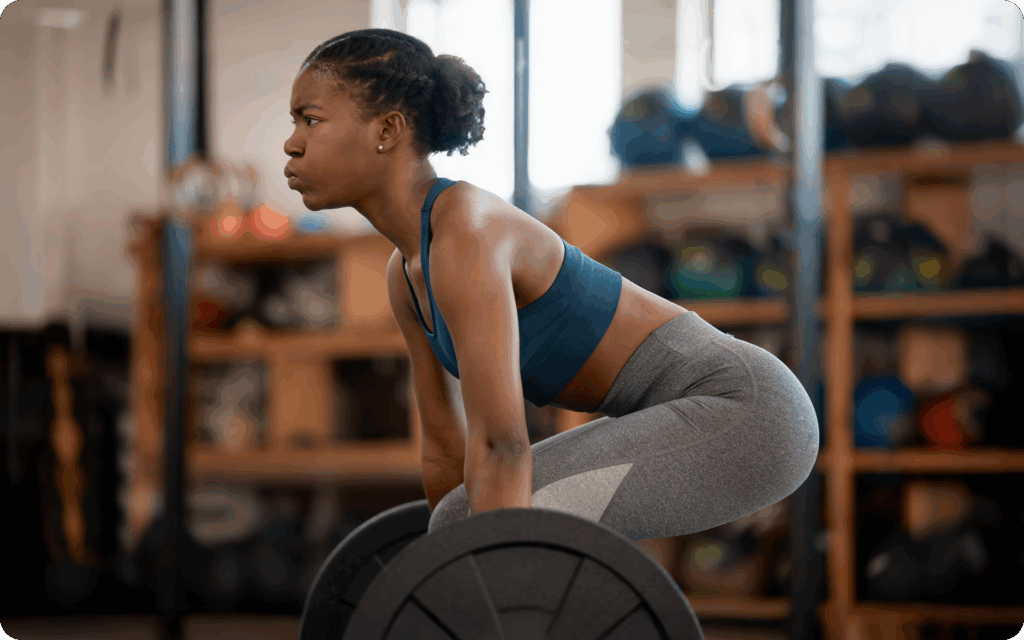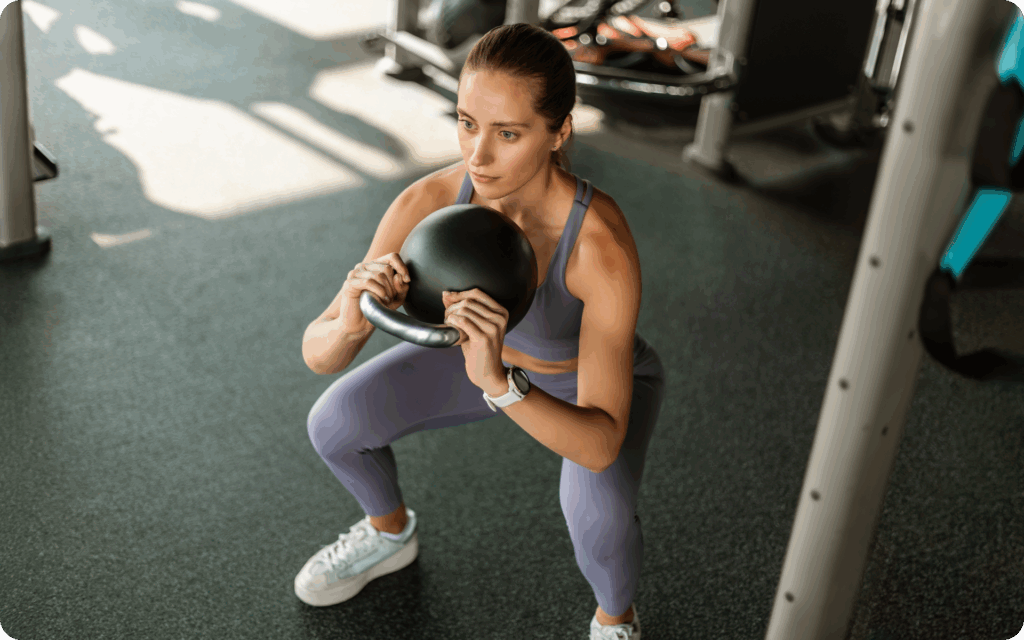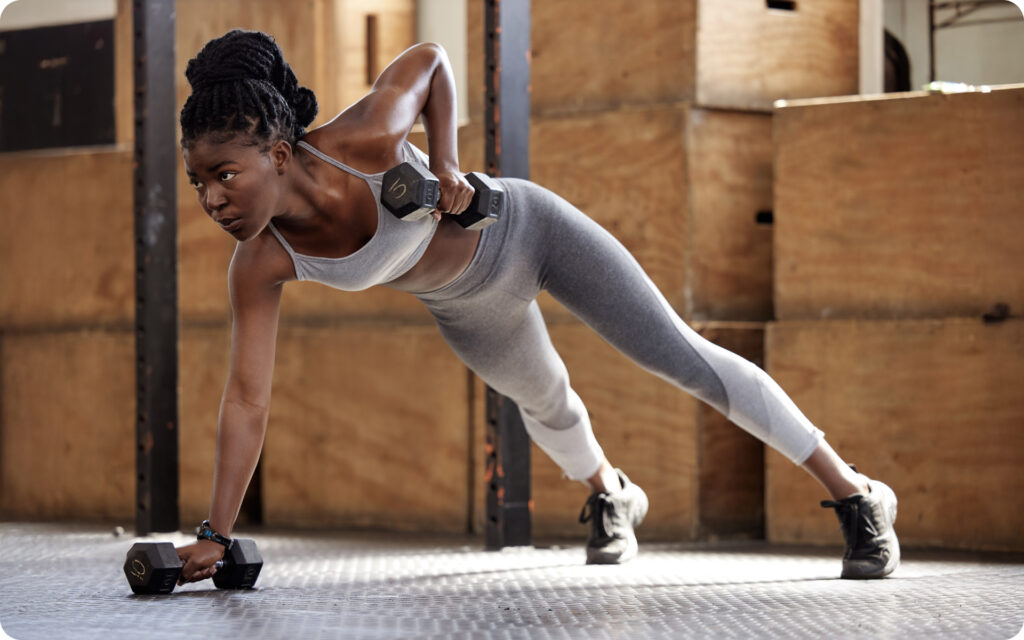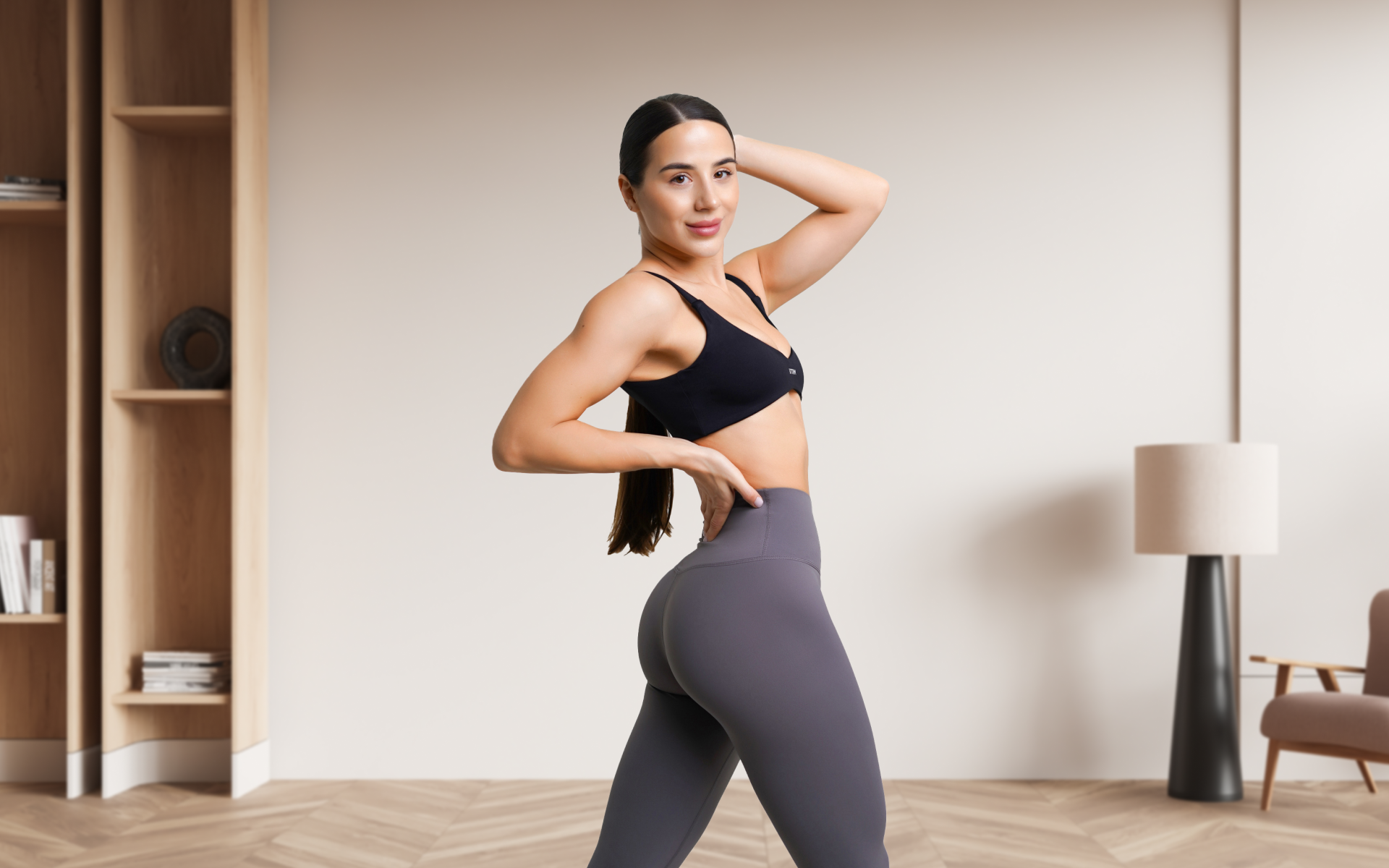Starting your fitness journey can feel overwhelming when you’re trying to lose fat and build muscle at the same time. But here’s what most people don’t realize: as a beginner, your body is primed for exactly this kind of transformation.
Your muscles are most responsive to training stimuli when you’re new to lifting. This means you can achieve impressive body recomposition – losing fat while gaining muscle – without the complex strategies that advanced lifters need. The key is understanding where you are on your fitness journey and applying the right approach for your experience level.
This guide will walk you through everything you need to know about creating an effective workout plan for fat loss and muscle gain, complete with actionable strategies you can implement immediately.
What to Do First: Lose Fat or Build Muscle?
As with most facets of fitness, experience matters. Where you are right now determines the route you’ll take to reach your goals. Your starting point will differ from others, meaning your approach should too.
Take a moment to assess where you fall on the beginner-to-veteran spectrum. Your experience level – both in the gym and with nutrition – significantly impacts how detailed your approach needs to be.
Beginner (0-2 Years of Lifting Experience)
If you’re new to resistance training, you’re in an advantageous position. A true beginner can build muscle and lose fat quite easily, simultaneously. This happens because your physiology is primed for muscle growth in a way it never will be again (1).
As you accumulate lifting experience, your muscles become increasingly adapted to training stimuli. With every passing year, building new muscle becomes slower and more challenging. As muscle building is energetically demanding, and beginners can build muscle faster (1), your body can pull calories from stored body fat to fuel the process.
This means beginners can achieve impressive body recomposition without obsessing over every nutritional detail. As long as you meet the following three key criteria, you should see results:
- Caloric intake is appropriate: You’re eating in a small caloric deficit or surplus – not drastically over- or undereating.
- Protein intake is adequate: You’re consuming enough protein to support muscle growth (we’ll cover specifics later).
- Progressive training: You’re weight training with a focus on progressive overload, gradually adding weight, volume, or improving technique over time.
Following these fundamentals will yield solid progress. However, implementing the advanced strategies that are outlined in this guide can take you from good results to great results.
The Obese Beginner
If you’re carrying significant excess body fat, you have an additional advantage. As you have substantial energy reserves, your body can easily tap into stored fat while building muscle, even in a caloric deficit (2). When obese individuals begin resistance training, simultaneous fat loss and muscle gain is common, which makes body recomposition particularly accessible.
Intermediate to Advanced (2-5+ Years of Lifting Experience)
The longer you’ve been training, the closer you are to your genetic potential for muscle growth. If you’re a weight room veteran, you’ll need to fight harder for continued progress as hypertrophy tends to plateau (3). This is where overlooked nutritional details truly move the needle.
For intermediate to advanced lifters, simply meeting the three beginner criteria likely won’t optimize results. Your body has become more resistant to change, requiring greater precision in your approach.
Reductionist concepts such as “calories in versus calories out” work adequately for beginners but can be limiting for experienced lifters. You’ll need to think deeper about nutrient timing, meal frequency, macronutrient distribution, and training variables to continue making progress (4, 5).
BetterMe: Health Coaching app helps you achieve your body goals with ease and efficiency by helping to choose proper meal plans and effective workouts. Start using our app and you will see good results in a short time.
Special Scenarios
Beyond the standard beginner-to-advanced spectrum, certain situations create unique opportunities for body recomposition.
- Detrained Lifters
If you’ve previously built significant muscle but stopped training due to injury, loss of motivation, or other circumstances, you’re considered “detrained”. Similar to new trainees, detrained lifters can build muscle rapidly when they return to training – a phenomenon linked to muscle memory (2).
When you resume training, your muscles remember their previous size and strength, allowing you to regain lost muscle much faster than you originally built it (6). This rapid muscle building creates conditions favorable for simultaneous fat loss.
- Anabolic Steroid Users
Using anabolic steroids dramatically accelerates muscle building, which puts users in a similar category to beginners and detrained lifters. The rapid muscle growth allows the body to tap into fat stores for energy (7), facilitating impressive recomposition. However, this guide focuses on natural training methods.
- Building Muscle While Maintaining Body Fat
Not all body recomposition involves losing fat mass. If you build muscle while maintaining your current body fat level, your body fat percentage still decreases because you’ve increased lean mass.
For example, you weigh 180 pounds at 20% body fat (36 pounds of fat). After training, you gain 10 pounds of muscle but maintain 36 pounds of fat. Now at 190 pounds, your body fat percentage drops to 18.9%, even though you didn’t lose a single pound of fat.
This scenario is common in already-lean trainees who find it difficult to drop additional body fat while still building muscle. If you’re curious about wether you can turn fat into muscle by lifting, check out our earlier article.
- Losing Fat While Maintaining Muscle
Conversely, if you lose fat while maintaining all your existing muscle mass, you’ve also achieved body recomposition. Typically, when people lose weight, they lose a combination of fat and muscle. Preserving muscle while losing pure fat creates a leaner, more muscular appearance.
This outcome is most common in advanced trainees who are already close to their genetic potential or in anyone who optimizes their diet but doesn’t train hard enough to stimulate new muscle growth.
Read more: How Long Does It Take To Lose 15 Pounds? What Science & Experts Say
What Is the Best Way to Lose Fat and Build Muscle?
Achieving body recomposition requires a strategic combination of three core elements: nutrition, weight training, and lifestyle factors. Each component plays a distinct role, and together they create the conditions that are necessary for simultaneous fat loss and muscle gain.
Nutrition: Fueling Your Transformation
Nutrition isn’t just about calories, it’s about providing your body with the raw materials it needs to build muscle while creating conditions for fat loss (8).
Practical application:
- Calculate your maintenance calories and aim for a small deficit (10-20% below maintenance) or slight surplus (5-10% above maintenance) depending on your starting body composition
- Prioritize protein intake at 0.8-1 gram per pound of body weight daily
- Distribute protein across 3-5 meals throughout the day for optimal muscle protein synthesis
- Time your largest carbohydrate-containing meals around your training sessions
- Include plenty of vegetables for micronutrients and fiber
- Stay hydrated with at least half your body weight in ounces of water daily
For more detailed guidance on structuring your nutrition, check out our Body Recomposition Diet Guide.
Weight Training: The Driving Force
Weight training is the engine of body recomposition (9). While you can lose fat through diet alone, building muscle without resistance training is almost impossible. Nutrition is permissive to weight training, which means you can eat perfectly, but without a training stimulus, you won’t build appreciable muscle.
Practical application (10):
- Train each muscle group at least twice per week
- Focus on progressive overload by gradually increasing weight, reps, or sets over time
- Prioritize compound movements (squats, deadlifts, presses, rows, pull-ups)
- Perform 10-20 working sets per muscle group per week
- Leave 1-3 reps in the tank on most compound exercises
- Take isolation exercises closer to failure, particularly on the last set
- Perform most working sets in the 6-15 rep range
Are you wondering if you can transform existing fat into muscle? Read our article on whether you can turn fat into muscle by lifting.
Lifestyle: Supporting Recovery and Adaptation
Your body builds muscle and burns fat during recovery, not during training. Sleep, stress management, and recovery protocols determine how well your body adapts to the stress you’ve placed on it (11).
Practical application:
- Prioritize 7-9 hours of quality sleep per night
- Manage stress through meditation, breathing exercises, or leisure activities
- Schedule rest days between intense training sessions
- Consider active recovery such as walking or light stretching on off days
- Monitor recovery markers such as resting heart rate and training performance
- Reduce alcohol consumption, which impairs muscle protein synthesis and recovery
Read more: High-Protein Low-Fat Meal Plan: Is Weight Loss Possible?
What Is an Effective Workout Plan for Fat Loss and Muscle Gain?
Now that we’ve covered the fundamentals, let’s build a practical workout plan. The best program is one you’ll actually stick to, but it must also meet certain criteria for effectiveness.
Choosing Your Training Split
Based on research showing that training each muscle group twice per week produces better results than once-weekly training (12), we recommend splits that allow this frequency. Here are proven options for beginners:
Upper/Lower Split (4 days per week)
- Day 1: Upper body
- Day 2: Lower body
- Day 3: Rest
- Day 4: Upper body
- Day 5: Lower body
- Days 6-7: Rest
Full-Body Split (3 days per week)
- Day 1: Full body
- Days 2-3: Rest
- Day 4: Full body
- Day 5: Rest
- Day 6: Full body
- Day 7: Rest
Both splits ensure each muscle group receives adequate training frequency for growth while providing sufficient recovery time.
Sample 4-Day Upper/Lower Program
This program is designed for beginners with 0-2 years of lifting experience. It emphasizes fundamental movement patterns and progressive overload.
Program Notes:
- Rest for 2-3 minutes between compound exercise sets
- Rest for 1-2 minutes between isolation exercise sets
- Start with weights that allow you to complete all prescribed reps with 1-3 reps left in the tank
- Add weight when you can complete all sets with good form and within the prescribed rep range
- Perform a general warm-up (5-10 minutes of light cardio) before each session
- Complete 1-2 warm-up sets with lighter weight before your first working set of each exercise
Day 1: Upper-Body A
| Exercise | Sets | Reps | Rest |
|---|---|---|---|
| Barbell bench press | 3 | 6-10 | 2-3 mins |
| Barbell row | 3 | 6-10 | 2-3 mins |
| Dumbbell shoulder press | 3 | 8-12 | 2 mins |
| Lat pulldown | 3 | 8-12 | 2 mins |
| Dumbbell bicep curl | 3 | 10-15 | 1-2 mins |
| Tricep cable pushdown | 2 | 10-15 | 1-2 mins |
| Exercise | Sets | Reps | Rest |
|---|---|---|---|
| Barbell back squat | 3 | 6-10 | 2-3 mins |
| Romanian deadlift | 3 | 8-12 | 2-3 mins |
| Leg press | 3 | 10-15 | 2 mins |
| Leg curl | 3 | 10-15 | 1-2 mins |
| Standing calf raise | 3 | 10-20 | 1 min |
| Plank | 3 | 30-60 sec | 1 min |
Day 3: Rest
Day 4: Upper-Body B
| Exercise | Sets | Reps | Rest |
|---|---|---|---|
| Incline dumbbell press | 3 | 8-12 | 2-3 mins |
| Pull-ups (or assisted) | 3 | 6-10 | 2-3 mins |
| Dumbbell lateral raise | 3 | 10-15 | 1-2 mins |
| Cable row | 3 | 8-12 | 2 mins |
| Hammer curl | 2 | 10-15 | 1-2 mins |
| Overhead triceps extension | 2 | 10-15 | 1-2 mins |
| Exercise | Sets | Reps | Rest |
|---|---|---|---|
| Front squat or goblet squat | 3 | 8-12 | 2-3 mins |
| Hip thrust | 3 | 8-12 | 2 mins |
| Walking lunges | 3 | 10-12 per leg | 2 mins |
| Seated leg curl | 3 | 10-15 | 1-2 mins |
| Seated calf raise | 3 | 12-20 | 1 min |
| Cable crunch | 3 | 12-20 | 1 min |
Days 6-7: Rest
This program provides 12-16 working sets per major muscle group per week, falling within the recommended 10-20 set range. As you progress, you can add sets, increase weight, or incorporate more advanced techniques.
For female-specific programming considerations, explore our workout plan for weight loss and muscle gain for women.
What Are the Signs of Body Recomposition?
Tracking progress during body recomposition can be tricky as the scale may not move much (or at all) when you’re simultaneously gaining muscle and losing fat. Here’s what to look out for:
- Visual Changes in the Mirror
You may notice your physique appearing more defined and muscular, even if your weight remains stable. Muscle takes up less space than fat (13), so you may see a more athletic, toned appearance with better muscle separation and definition.
- Strength Increases
Progressive strength gains in the gym – lifting heavier weights or completing more reps with the same weight – can indicate muscle growth. If you’re getting stronger while maintaining or losing weight, you’re likely building muscle.
- Clothing Fit Differently
Your clothes may fit differently in revealing ways. Pants may feel looser around the waist but tighter in the thighs and glutes. Shirts may feel snugger around the chest and shoulders but looser around the midsection.
- Body Measurements Shift
Taking regular circumference measurements can reveal recomposition progress. You may see decreases in waist and hip measurements while noting increases in chest, shoulder, and thigh measurements.
- Improved Body Composition Metrics
If you have access to body composition testing (DEXA scan, bioelectrical impedance, or skinfold calipers), you may see decreasing body fat percentage alongside stable or increasing lean mass measurements. These provide the most objective evidence of recomposition (14).
- Enhanced Athletic Performance
You may notice improved endurance, speed, or power output during workouts or sports activities. Better performance often reflects favorable changes in body composition.
Remember that these signs are nuanced and individual. Not everyone experiences all markers, and progress rates vary significantly based on training experience, genetics, and adherence to programming.
How Long Does Body Recomposition Take?
The timeline for body recomposition varies dramatically based on individual factors such as training experience, starting body composition, genetics, adherence to programming, and recovery capacity.
For beginners, noticeable changes may appear within 4-8 weeks of consistent training and nutrition. The “newbie gains” phase allows for relatively rapid progress – potentially gaining 1-2 pounds of muscle per month while simultaneously losing fat.
Intermediate lifters (2-5 years of experience) should expect slower progress, with muscle gains of 0.5-1 pound per month representing excellent progress. Body recomposition becomes more challenging as you advance, requiring greater precision in training and nutrition.
Advanced trainees near their genetic potential may find pure body recomposition difficult, sometimes requiring dedicated bulking or cutting phases rather than simultaneous muscle gain and fat loss. However, maintaining muscle while losing fat (one form of recomposition) remains achievable.
The nuanced nature of these timelines means that patience is essential. Body recomposition is a marathon, not a sprint. Focus on consistent training, adequate protein intake, progressive overload, and sufficient recovery rather than fixating on rapid transformation.
Most individuals can expect meaningful, visible changes within 12-16 weeks of dedicated effort, with more dramatic transformations occurring over 6-12 months of consistent adherence.
Most individuals require 7-9 hours of quality sleep per night for optimal body recomposition. Sleep is when your body releases growth hormone, repairs damaged muscle tissue, and consolidates the adaptations from training. Insufficient sleep impairs muscle protein synthesis, increases cortisol (a catabolic hormone), and makes fat loss more difficult (15, 16). Prioritize consistent sleep schedules, a cool dark bedroom, and limiting screen time before bed to maximize sleep quality. Your caloric needs depend on your current body composition and training status. Beginners can often achieve body recomposition while eating at maintenance calories or in a slight deficit (10-15% below maintenance). More advanced trainees may need to eat at maintenance or in a very slight surplus (5-10% above maintenance) to support muscle growth while minimizing fat gain (17). The key is to ensure adequate protein intake (0.7-1g per pound of body weight) regardless of your total caloric intake (18). Track your weight and measurements over 2-4 weeks to assess whether your current caloric intake is supporting your recomposition goals. For more details about meal plan for weight loss and muscle gain for female, take a look at our prior publication. While cardio burns more calories during the activity itself (19), weightlifting provides superior long-term fat loss benefits through increased muscle mass and elevated metabolic rate (20). Muscle tissue requires more energy to maintain than fat tissue, meaning more muscle equals higher daily calorie expenditure (21). For optimal body recomposition, prioritize weight training while incorporating moderate cardio (2-3 sessions per week) to support cardiovascular health and create additional caloric expenditure without interfering with recovery (22). Yes, lifting dumbbells (and other forms of resistance training) supports fat loss through multiple mechanisms. Resistance training builds muscle mass (23), which increases your resting metabolic rate (24). However, dumbbells alone won’t cause fat loss – you must also maintain an appropriate caloric intake that creates conditions for fat oxidation. Think of dumbbell training as preserving and building muscle, while proper nutrition creates the caloric environment for fat loss. Together, they produce body recomposition.Frequently Asked Questions
How much sleep do I need for body recomp?
How many calories should I be eating to gain muscle and lose fat?
Does cardio or weightlifting burn more fat?
Does lifting dumbbells burn fat?
The Bottom Line
Body recomposition isn’t just possible, it’s achievable with the right strategy, consistency, and patience. Whether you’re a complete beginner with significant newbie gains ahead or an experienced lifter fine-tuning your approach, the principles remain the same: progressive resistance training, adequate protein intake, appropriate caloric intake, and sufficient recovery.
Start by honestly assessing where you fall on the training experience spectrum. Implement the workout program that we’ve outlined above, prioritize your nutrition, and give your body the recovery it needs to adapt. Track your progress through multiple metrics – not just the scale – and adjust your approach based on what the data tells you.
Remember that body recomposition is a gradual process. Focus on weekly progress in the gym, consistent adherence to your nutrition plan, and the lifestyle factors that support adaptation. The physical transformation you’re looking for is built through accumulated effort over months, rather than days.
DISCLAIMER:
This article is intended for general informational purposes only and does not serve to address individual circumstances. It is not a substitute for professional advice or help and should not be relied on for making any kind of decision-making. Any action taken as a direct or indirect result of the information in this article is entirely at your own risk and is your sole responsibility.
BetterMe, its content staff, and its medical advisors accept no responsibility for inaccuracies, errors, misstatements, inconsistencies, or omissions and specifically disclaim any liability, loss or risk, personal, professional or otherwise, which may be incurred as a consequence, directly or indirectly, of the use and/or application of any content.
You should always seek the advice of your physician or other qualified health provider with any questions you may have regarding a medical condition or your specific situation. Never disregard professional medical advice or delay seeking it because of BetterMe content. If you suspect or think you may have a medical emergency, call your doctor.
SOURCES:
- Resistance Training Load Effects on Muscle Hypertrophy and Strength Gain: Systematic Review and Network Meta-analysis (2021, journals.lww.com)
- Body Recomposition: Can Trained Individuals Build Muscle and Lose Fat at the Same Time? (2020, journals.lww.com)
- The Plateau in Muscle Growth with Resistance Training: An Exploration of Possible Mechanisms (2024, pubmed.ncbi.nlm.nih.gov)
- International society of sports nutrition position stand: nutrient timing (2017, pmc.ncbi.nlm.nih.gov)
- Meal Frequency and Nutrient Distribution: What is Ideal for Body Composition? (2014, researchgate.net)
- The concept of skeletal muscle memory: Evidence from animal and human studies (2020, pmc.ncbi.nlm.nih.gov)
- The Uses of Anabolic Androgenic Steroids Among Athletes; Its Positive and Negative Aspects- A Literature Review (2023, pmc.ncbi.nlm.nih.gov)
- What to Eat to Gain Muscle (2024, issaonline.com)
- Effect weight training on muscular hypertrophy: a systematic review (2023, researchgate.net)
- Progression Models in Resistance Training for Healthy Adults (2009, journals.lww.com)
- Exploring the Science of Muscle Recovery (n.d., blog.nasm.org)
- Effects of Resistance Training Frequency on Measures of Muscle Hypertrophy: A Systematic Review and Meta-Analysis (2016, link.springer.com)
- The Difference Between Muscle Weight vs. Fat Weight (2024, health.clevelandclinic.org)
- Body Composition Measurement: Accuracy, Validity, and Comparability (1990, ncbi.nlm.nih.gov)
- The effect of acute sleep deprivation on skeletal muscle protein synthesis and the hormonal environment (2021, physoc.onlinelibrary.wiley.com)
- The Potential Role of Sleep in Promoting a Healthy Body Composition: Underlying Mechanisms Determining Muscle, Fat, and Bone Mass and Their Association with Sleep (2021, karger.com)
- Effect of Small and Large Energy Surpluses on Strength, Muscle, and Skinfold Thickness in Resistance-Trained Individuals: A Parallel Groups Design (2023, sportsmedicine-open.springeropen.com)
- International Society of Sports Nutrition Position Stand: protein and exercise (2017, jissn.biomedcentral.com)
- Exercises That Burn the Most Calories (2024, health.clevelandclinic.org)
- Adaptations to Endurance and Strength Training (2018, pmc.ncbi.nlm.nih.gov)
- Muscle cells vs. fat cells: MedlinePlus Medical Encyclopedia Image (2022, medlineplus.gov)
- What To Know About Body Recomposition (2024, health.clevelandclinic.org)
- Maximizing Muscle Hypertrophy: A Systematic Review of Advanced Resistance Training Techniques and Methods (2019, pmc.ncbi.nlm.nih.gov)
- Increasing muscle mass to improve metabolism (2013, pmc.ncbi.nlm.nih.gov)

